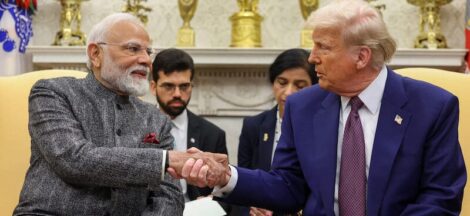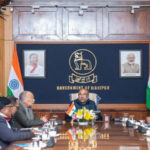By Anand Grover
With the international rules based order in disarray today and as parameters of governance are undermined across the world, the crisis in health is looming large. Having been through two major pandemics in the recent past – HIV and Covid – it is now instructive for health activists to reflect and understand what the future holds for us.
The responses to the two epidemics have been very different in terms of the role of the affected communities and whether they were objects or subjects in the response, and the role of the State and the pharmaceutical (pharma) companies in making the treatment available and accessible.
In 1981 when HIV hit the world, it was an unknown ailment, wreaking havoc to the lives of the affected, first in the US and then all over the world. It was a “disease of the wretched of earth” first affecting gay men (initially in the US), and later sex workers, and drug users, all marginalized and stigmatised groups of the population. Because of those initially affected, the response was based on prejudice and therefore very negative towards the affected populations. It was what I termed as the ‘isolationist’ response – testing for HIV was often done without consent, confidentiality of the person reporting positive was regularly breached and then they were isolated. Statutes around the world were based on that. The Goa Public Health (Amendment) Act and the Bombay High Court’s decision in Lucy R. D’Souza v. State of Goa (1989) precisely dealt with these issues.
In that period the gay movement in the US developed the ‘buddy system’ for HIV affected persons to help each other during the often lonely final days of this fatal disease. People living with HIV who had been disassociated from the family and even with their loved ones were given succour in their lonely road to death.
Based on validated scientific and rights-based strategies, rights of the communities – gay men, sex workers, and drug users, who are most vulnerable to HIV, were respected, protected and advanced, preventing the further transmission of HIV. Most importantly these communities were actively involved in the decision-making processes. ‘Nothing about us without us’ became the slogan of the movement as the communities came to the forefront of the fight against the HIV pandemic.
Harm reduction was the tool that was deployed to involve the communities. The idea was to use tools which would prevent the transmission of HIV, the key goal, without casting aspersions or prejudice upon the affected communities. Sex workers and gay men were trained to negotiate the use of condoms with their clients and partners. Injecting drug users were urged to exchange used syringe needles. Eventually, because the affected communities were empowered and actively involved in the global fight against the HIV pandemic, the disease’s prevalence was brought down internationally.
Initial evidence on the success of these strategies came from the peer reviewed study based in Sonagachi (a red-light area in Kolkata, India). Empowering sex workers on their civic and other rights empowered them to negotiate safe sex and condom use. With increase in condom use with clients by sex workers from 3 percent in1992 to 90 percent in 1998 over a period of seven years, STD rates (a surrogate marker for HIV) declined from 25 percent to 11 percent. This was later supported by epidemiological data from Tamil Nadu in southern India where sero-prevalence in women aged between 15 and 24 years, tested nationally at ante-natal clinics, decreased by 54 percent between 2000 and 2007.
The strategies employed in the HIV response were in consonance with the international Right to Health, which underscores that everyone is entitled to a health system that makes goods, services and facilities, including information relating to them, ‘available’ in adequate numbers; ‘accessible’ physically and geographically and economically affordable in a non-discriminatory manner.
Treatment must only be administered on a consensual basis to protect people’s right to control their health and body and be respectful of their autonomy and dignity.
Informed consent involves the disclosure of the associated benefits, risks, and alternatives to a medical procedure. States are required to have a plan for the roll out of health care goods, services and facilities, as well as indicators to review the progress for monitoring and accountability.
Treatment for HIV did not come about through the altruism of Big Pharma or its desire to innovate for the community. It was the gay men’s movement in the US that had to fight for the very survival of their members. They launched a valiant struggle to get medicines fast-tracked. Their tactics were to target the pharma industry and the US Food and Drug Administration (‘FDA’) by occupying their offices. They were able to force Big pharma to innovate and the FDA to release experimental drugs to them for treatment before they were formally approved for sale in the market.
From being without any treatment or cure in the early 1980s, HIV became a treatable ailment in the mid 1990s. The relationship between Big Pharma and the communities was epitomised by legal action taken by 39 pharmaceutical companies from around the world in challenging the South African Medicines and Related Substances Control Act in the Pretoria High Court. The Act inter alia allowed parallel importing of drugs to make HIV Antiretroviral therapy (‘ARV’) accessible in South Africa.
The affected communities challenged the action of Big Pharma on the streets with demonstrations around the world and prompting the South African government to be proactive in defending the Act. This led to Big Pharma finally withdrawing their legal action resulting in a major victory for access to ARVs.
Because of the absence of patent protection in India, Indian generic companies were able to market the generic ARVs at affordable prices. Indian generic industry was able to supply high quality ARVs to initially, the developed world, including South Africa and later, even to the developing world. The United States Agency for International Development, the United States President’s Emergency Plan for AIDS Relief, the World Health Organisation and USAID, PEPFAR, WHO and Unitaid supplied generic ARVs to the People Living with HIV (‘PLHIV’) all over the world.
Most of the PLHIVs could be delivered the triple combination therapy and millions of lives were saved. Today we have an international target of getting rid of HIV/AIDS by 2030, which is now delayed first because of COVID and later due to cut back in funding. In another decade, HIV could be eradicated. HIV is the only pandemic which was fought on the basis of rationality, science, rights based strategies involving affected communities in the decision making processes and strategies in the battle against HIV have proven to be a success story!
COVID, like HIV, was also an unknown disease, when it first appeared and like HIV wreaked havoc. Because it appeared to affect a large, and a rather mainstream (though select) section of the population, the response was not dictated by prejudice. Apart from the issue of mandatory vaccination, the overall response was not based on the rights of the affected people. Except in very few places, the affected communities were not involved in the decision-making process. The response was dictated by the world governments prompted by Big Pharma.
In most countries responses were ad hoc. Recurrent waves were not anticipated. Because of a lack of planning (not anticipating the waves) and inadequacy of facilities (oxygen supply), goods and services for a large-affected population, marginalized communities (indigenous, ethnic minorities and LGBTQI populations) suffered disproportionately. Sex workers in India had no work and no food. For most countries, the numbers of preventable deaths was disastrous.
Because the first wave was mild, India projected that it was among the countries who had “succeeded in saving the maximum lives” and saving “the world from disaster by bringing the situation under control.” This false notion of exceptionalism led to complacency. The second wave was thusa not anticipated. The Indian government had let its guard down. This led to a downsizing of health facilities. The shortfall in medical infrastructure, particularly the lack of hospital beds, oxygen equipment and medicines wreaked havoc in the lives of people with devastating consequences in the second wave. People ran from pillar to post to save their loved ones without help from the authorities.
In some states in India, lack of cremation facilities led families to bury the dead in the sand along the river. The devastation was so acute that most Indians know at least one family member or friend who passed away due to COVID.
Like elsewhere, in India too there was severe underreporting of the total number of fatalities from COVID. Figures vary from the official figures of 535,570 to 4,7 million (a number which is eight times more).
Lockdowns in India caused devastation to migrant workers who had moved to metropolitan urban centres for work. They lost their jobs. With no transportation available, they walked thousands of miles to their hometowns, with some suffering death with no succour or compensation from the government.
In Brazil, throughout the COVID pandemic, the President and the Governors of States were locked in conflict. President Jair Bolsonaro viewed the COVID Pandemic as a “mere flu, about which there is not much to be worried about.” He thought that any lockdown “would cause hunger and chaos” and did not permit the imposition of any lockdown measures. Anybody advocating lockdown/s was seen as a foreign agent to further the strategy of the “Chinese to damage the world.” Brazil with 2.7 percent of the world’s population had 12.6 percent of all the deaths globally.
São Paulo, the most populous (46 million people) and the richest state of Brazil, had its first case of COVID on February 26, 2020 and first death on March 17, 2020. Later, it had the highest number of infections (2,597,366 in number) and deaths (80,742 in number), resulting in a mortality rate of 175.8/100,000 people. In Amazonas, the Brazilian state with the largest landmass and an estimated population of 4.21 million, which hosts the largest tropical forest in the world, the arrival of the pandemic coincided with the worsening of chronic problems in the region, including the invasion of forest land, increase in illegal logging, deforestation to accommodate agri-business, and actions that some argue, constituted a genocide of the indigenous populations of the region.
The COVID pandemic in Amazonas was considered to be the most disastrous in Brazil. By April 2021, there were 355,897 confirmed cases of COVID 19 and 12,202 deaths with the mortality rate of a staggering 294.4 deaths/100,000 people, the highest in Brazil and higher than any other country in the world. There was a complete collapse of the health system at the height of the pandemic and in Manaus, Amazonas’ capital, 30 percent of the deaths occurred at home or on the streets. Brazil also performed the worst in terms of the number of ICU beds available, with only seven available for 100,000 inhabitants. The funeral system across Amazonas, particularly in Manaus, collapsed.




 Truce Talks On Manipur Failed To Produce Joint Statement Despite Meeting Of Both Sides
Truce Talks On Manipur Failed To Produce Joint Statement Despite Meeting Of Both Sides 